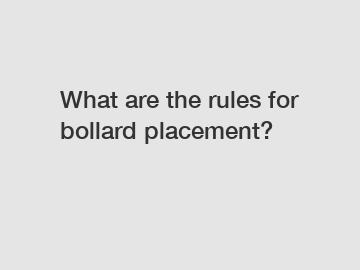What are the rules for bollard placement?
What are the rules for bollard placement?
Bollards are an essential element in urban design, providing safety and security to pedestrians, buildings, and infrastructure. They are sturdy, short, vertical posts that act as barriers, preventing vehicle intrusion and controlling pedestrian traffic. Their strategic placement can effectively enhance safety and manage traffic flow. However, to ensure their effectiveness, there are specific rules and guidelines that govern their placement. In this article, we will explore the rules for bollard placement.
Purpose of Bollards.

Before delving into the rules of bollard placement, it is crucial to understand their primary purpose. Bollards serve multiple functions in urban environments, including:
1. Traffic Control: Bollards can be strategically placed to guide and control the flow of vehicular traffic, preventing unauthorized entry into specific areas and ensuring pedestrian safety.
2. Physical Security: Bollards act as physical barriers to prevent intentional vehicle attacks, safeguarding critical infrastructure, crowded places, and pedestrian zones from potential threats.
3. Pedestrian Safety: By delineating pedestrian-only areas and creating a separation between vehicles and pedestrians, bollards increase safety for those on foot.
4. Maintenance and Protection: Bollards protect buildings, storefronts, and other vulnerable structures from accidental vehicle damage, ensuring their longevity and reducing repair costs.
Rules for Bollard Placement.
1. Clear Zone Requirements:
To achieve maximum effectiveness, bollards must be placed with proper clear zone requirements. This refers to the space needed around a bollard to prevent vehicles from striking objects behind it. Clear zone requirements depend on various factors, such as the speed limit of the adjacent roadway, the type and weight of vehicles passing through, and the specific area being protected.
2. Spacing and Height:
Bollards should be appropriately spaced to create a barrier that vehicles cannot penetrate. Generally, spacing between bollards should be no more than 5 feet apart. Heights of bollards should be carefully considered, with taller bollards typically used for security purposes to provide a stronger deterrent against vehicle intrusion.
3. Visibility and Illumination:
Bollards should be highly visible to both pedestrians and drivers. Reflective materials, bright colors, or integrated lighting can improve visibility during low-light conditions. Illuminated bollards can enhance aesthetics while increasing safety and preventing accidents.
4. ADA Compliance:
To ensure accessibility for people with disabilities, it is essential to comply with the guidelines set forth by the Americans with Disabilities Act (ADA). Bollards should not impede the path of travel for wheelchair users or those with limited mobility. Careful consideration of spacing and placement is necessary to maintain accessibility.
Conclusion.
Bollard placement is a critical aspect of urban design. When strategically positioned, bollards act as effective barriers, providing safety, security, and traffic control. Understanding and adhering to the rules and guidelines for bollard placement is vital to optimize their functionality. These rules include clear zone requirements, appropriate spacing, visibility, and ADA compliance. By following these guidelines, urban planners and designers can create safer, more secure, and pedestrian-friendly environments.
For more information on bollard placement or to inquire about bollard installation services, please contact us. We are here to assist in ensuring your urban spaces remain safe, protected, and visually appealing.
Are you interested in learning more about Semi-automatic Bollards, best hydraulic wedge barrier, automatic bollard? Contact us today to secure an expert consultation!

Comments
0